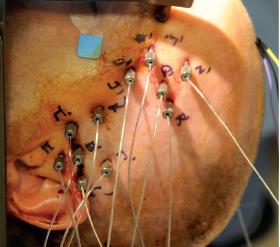Table of Contents
Stereoelectroencephalography guided radiofrequency thermocoagulation
Indications
Concerns about the impact of open surgery for drug-resistant mesial temporal lobe epilepsy with hippocampal sclerosis (MTLE-HS) have driven interest in minimally invasive techniques. Stereoelectroencephalography guided radiofrequency thermocoagulation (SEEG guided RF-TC) offers an alternative choice but with currently limited efficacy. Fan et al. developed a procedure for optimally extended thermocoagulation lesions and investigated the efficacy and safety of MTLE-HS in a preliminary observational study. Optimized SEEG-guided RF-TC is a promising complementary option for the treatment of MTLE-HS 1).
Despite the increasing number of studies reporting results of stereo-electroencephalography (SEEG)-guided radiofrequency-thermocoagulation (SEEG-guided RF-TC) in the treatment of patients with drug-resistant focal epilepsy, the exact efficacy of this approach remains unclear. The seizure-freedom rate varies greatly across studies and the factors associated with efficacy have not been formally investigated.
All prospective or retrospective studies reporting efficacy and/or safety of SEEG-guided RF-TC in patients with drug-resistant focal epilepsy were included. The primary outcome was the seizure-free rate 1 year after the procedure. Secondary outcomes were (1) the responder rate 1 year after the procedure and (2) the proportion of patients with permanent neurologic deficit 1 year after the procedure. Each outcome was assessed in all patients and in 4 groups of patients defined by the etiology of epilepsy. Each outcome was pooled using inverse variance weighting, logit transformation of proportion, and a random-effects model.
No prospective study was identified and a total of 6 retrospective studies, reporting efficacy and safety data of 296 patients, were included. The pooled rate of permanent neurologic deficit was 2.5% (95% confidence interval [CI] 1.2%-5.3%), without heterogeneity across studies. In contrast, both the seizure-free and responder rates varied greatly across studies, and statistical heterogeneity was high. The pooled seizure-free and responder rates were 23% (95% CI 8%-50%) and 58% (95% CI 36%-77%), respectively. Both for the seizure-free and responder rates, the greatest efficacy was observed in patients with periventricular nodular heterotopia and the lowest in patients with normal magnetic resonance imaging (MRI) findings.
SEEG-guided RF-TC is a safe procedure with low risk of complications. In contrast, the level of evidence regarding its efficacy remains low. Better identification of factors associated with seizure outcome are needed 2).
Case series
An observational cohort study was performed on 19 MRI-negative epilepsy patients who underwent stereoelectroencephalography guided radiofrequency thermocoagulation (SEEG-guided RF-TC) in an epilepsy center. In addition, 16 MRI-positive patients were included as a reference group. Semiology, electrophysiology, and imaging information were collected. To evaluate the value of locating the MEG cluster, the proportion of the RF-TC contacts located in the MEG cluster out of all contacts used to perform RF-TC in each patient was calculated. All patients underwent the standard SEEG-guided RF-TC procedure and were followed up after the treatment.
Nineteen MRI-negative patients were divided into two groups based on the existence of MEG clusters; 10 patients with MEG clusters were in group I and nine patients without any MEG cluster were in group II. No significant difference was observed in terms of age, sex, type of seizures, or a number of SEEG electrodes implanted. The median of the proportion of contacts in the MEG cluster was 77.0 % (IQR 57.7-100.0 %). The follow-up results showed that the probability of being seizure-free at one year after RFTC in MRI-negative patients with a MEG cluster was 30.0 % (95 % CI 11.6-77.3 %), significantly (p = 0.014) higher than that in patients without a MEG cluster; there was no significant difference when compared with MRI-positive patients.
This is the first study to evaluate the value of MEG in SEEG-guided RF-TC in MRI-negative epilepsies. MEG is a useful supplement for patients with MRI-negative epilepsy. MEG can be applied in minimally invasive treatment. MEG clusters can help identify better candidates and provide a valuable target for SEEG-guided RF-TC, which leads to better outcomes. 3).
From June 2016 to August 2017, twenty-two patients were selected for the present study. They met the criteria of unilateral MTLE-HS after noninvasive evaluation and then underwent implantation of a combination of SEEG electrodes to form a high-density focal stereo-array, including one electrode along the long axis of amygdalohippocampal complex and three orthogonal electrodes to widely sample mesial temporal structures. A unilateral epileptogenic zone of mesial temporal structures was confirmed in these 21 patients. SEEG-guided bipolar coagulations were performed between two contiguous contacts of the same electrode, or between two adjacent contacts of different electrodes.
Surgical procedures were well tolerated, with no related complications. At the follow-up of 12 months, 20 patients (95.2%) experienced a >90% decrease in seizure frequency and 16 patients (76.2%) were free of disabling seizures (Engel class I). Among them, eight (38.1%) were classified as Engel class Ia and the other eight (38.1%) as Engel class Ib. Four others (19%) had rare disabling seizures (Engel class II). Only one (4.8%) experienced an Engel class III outcome.
Optimized SEEG-guided RF-TC is a promising complementary option for the treatment of MTLE-HS 4).
